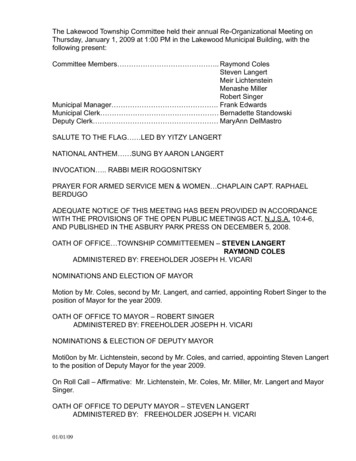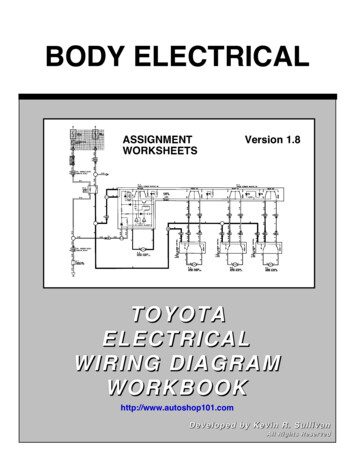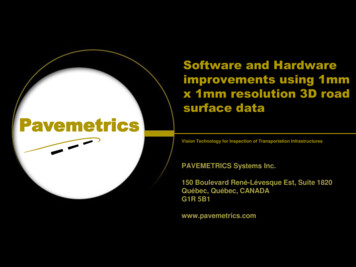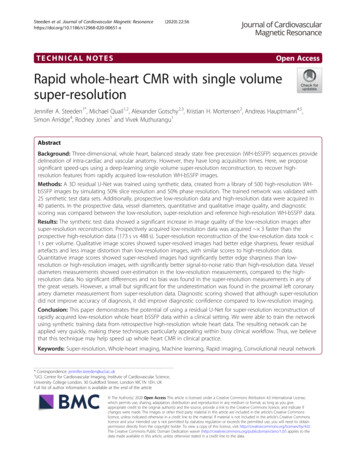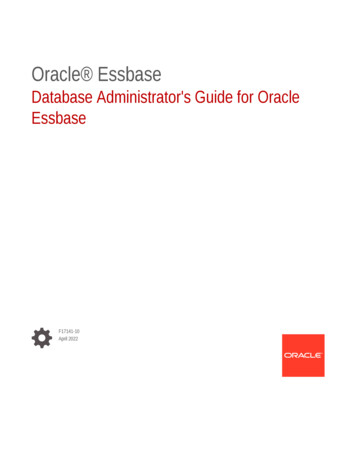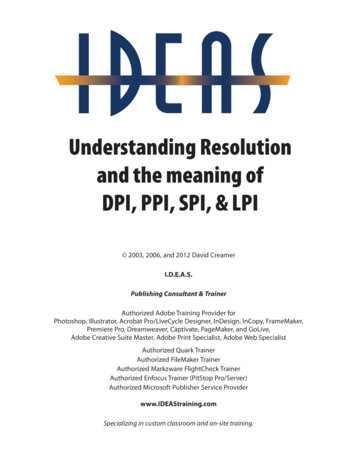
Transcription
Understanding Resolutionand the meaning ofDPI, PPI, SPI, & LPI 2003, 2006, and 2012 David CreamerI.D.E.A.S.Publishing Consultant & TrainerAuthorized Adobe Training Provider forPhotoshop, Illustrator, Acrobat Pro/LiveCycle Designer, InDesign, InCopy, FrameMaker,Premiere Pro, Dreamweaver, Captivate, PageMaker, and GoLive,Adobe Creative Suite Master, Adobe Print Specialist, Adobe Web SpecialistAuthorized Quark TrainerAuthorized FileMaker TrainerAuthorized Markzware FlightCheck TrainerAuthorized Enfocus Trainer (PitStop Pro/Server)Authorized Microsoft Publisher Service Providerwww.IDEAStraining.comSpecializing in custom classroom and on-site training.
Understanding DPI, ppi, SPI, and lpiBy David CreamerScanners: SPI (samples per inch) or ppi (pixels per inch)PPI (pixels per inch) works for scanner input, but technically, spi is more accurate. For example, if you scan 200% at 1200 ppi or if you scan at 100% at 2400 ppi, the scanner “sees” orsamples the same data. The ppi, when viewed in Photoshop, is different for each file, but thesampling of the original by the scanner is the same. The maximum spi of a given device iscapable of is the optical resolution at 100%.SCAN TIPSAlways scan at no more than your maximum optical resolution. This number is not the largenumber advertised on the box (9600 dpi resolution!), but the smaller number tucked awaysomewhere in the specifications. If your scanner has a 2400 spi optical resolution and youdetermine that you need an image resolution of 300 ppi, you can scan at a maximum of 800%(300 ppi x 8.00 2400 ppi). If your scanner lists an optical resolution of 4800 x 2400, use thesmaller number for your calculations.If you determine that you only need 266 ppi for your images, scan at a “native” resolutionof your scanner. If you have a 2400 spi optical resolution scanner, scan only at 2400, 1200(200% maximum enlargement), 600 (400% maximum enlargement), or 300 (800% maximumenlargement) ppi. Then resize or resample the resolution to 266 ppi in Photoshop after you arefinished scanning.Digital Cameras: Width x Height Pixels onlyA digital camera can capture data based on the mega-pixel ability of its CCD. For example, an8 mega-pixel digital camera shoots at approximately 3264 x 2448 pixels (different brand cameras may vary in size slightly). 3264 pixels * 2448 pixels 7,990,272 total pixels (rounded up).Some may refer to the pixel capture size (18 mega-pixel) as the camera’s resolution. From a ppiviewpoint, camera images mostly have no resolution assigned to them (although some highend cameras can set this). However, when you open the file into most image-editing programs,such as Photoshop, a reso lution is assigned to the file. Most programs, including Photoshop,use 72 ppi as a default resolution. It is incorrect to say that digital camera images have a resolution of 72 ppi since it is the software program assigning that number.Copyright 2006 by David Creamer2www.IDEAStraining.com
Monitors: Width x Height Pixels onlyMonitor resolution is measured strictly by pixel width and height. Some common settings are1280x1024, 1920x1080, and even 2880x1800. Different size monitors could be set to the sameresolution, so there is no default ppi setting for monitors since ppi depends on the monitorresolution and the physical size of the monitor. For example, a 1920x1080 monitor could be 17inches (monitor sizes are measured diagonally like TVs) or could be 22 inches, so the actualppi would be different for each.Some repeat the old settings of Mac monitors displaying at 72 ppi and Windows displaying at96 ppi, that that standard went away years ago with more modern monitors. This informationis inaccurate (since ppi depends on resolution and size, as mentioned) and should not be used.That being said, programs assume a default resolution, so you will still see those numbers usedin software, but it does not reflect reality.Web & Video Graphics: Width x Height Pixels onlyWeb Graphics also are measured strictly by X/Y pixels only, usually in relation to a monitorsize. Basically, one image pixel of a web graphic displays on one monitor pixel*. A web graphicthat is 800x600 pixels will completely fill up a monitor set to 800x600, but only fill 25% of thescreen of a monitor set to 1600x1200. A common misconception is that web graphics have aresolution of 72 ppi, but that is completely inaccurate. An image that is 800x600 pixels at 72ppi will display in a web browser the same size as a graphic that is 800x600 pixels at 300 ppi—essentially it will take up 800x600 pixels on whatever monitor it is on.*At Actual Pixels (100%) in Photoshop also display one image pixel for one monitor pixel.(Many web-only graphics programs do not assign resolution to graphics and work strictly bypixel dimensions.)Video graphics work the same as web graphics except they have some per-determined pixelsettings. A standard-definition video (SD) setting for TV is 720x480 pixels (surprisingly lowresolution compared to print), the high-definition video setting is often 1920x1080 (althoughit varies by type of camera). It should also be mentioned that video may have different shapedpixels; they can be square, vertical, or horizontal. Video editing programs and Photoshopcompensate for the different pixel shape by “distorting” the image on screen.Image resolution for printing: ppi (pixels per inch)(If you are new to commercial printing, it may be useful if you read the lpi and dpi sections first,before reading this section.)Excess resolution is not used when printing the file and only does three things: make your files larger than necessary, increase the printing time, and it may have the effect of “softening” your images.The best solution is to have the maximum amount of resolution REQUIRED, based on yourfinal image size, your printing method, and line screen used.Copyright 2006 by David Creamer3www.IDEAStraining.com
AM (Halftone) ScreeningFor print, images need a minimum resolution, measured in pixels per inch or ppi (this shouldnot be called “dots per inch”), in order to have enough detail and look natural. The amount ofresolution required mostly depends on lpi (see following section). For example, the resolutionrequired is approximately 1.5 times the lpi, although many printers still require 2 times the lpi(better printers will give a desired ppi range, such as 225-300 ppi). For example, when printingat 150 lpi (a common lpi for magazines), the image resolution should be 225 ppi (or 300 ppiif using the 2X method). If using the 1.5xlpi resolution setting, it is important not to scale theimage up in the layout program since the image is already at it’s maximum size for optimumquality. Using the 2x resolution calculation results in having 4 image pixels to 1 halftone dot,whereas the 1.5 resolution calculation results in 2.25 pixels to 1 halftone dot. Technically, theactual requirement for AM screening is 1.414 (rounded) resulting in 2 pixels to make 1 halftone dot. When creating the halftone dot, the pixels are averaged for an overall shade of grayand then the corresponding halftone dot is produced in the RIP (raster image processor).Line screens, measured in lpi, have ink dots arranged in a set pattern with different inksprinted at different angles; black is usually printed at 45 , . Since printers can only put down asolid dot of ink, various tones are created by different dot sizes. However, the dots, regardlessof size, are always spaced out the same distance (determined by the lpi).AM Screening ChartPrinting Method1.5 X MethodFile dimensions: 8x10 in.PPISize for RGB(in MB)Newsprint — 100 LPI150Magazine — 133 LPI200Magazine — 150 LPI2 X MethodSize for CMYK(in MB)PPISize for RGB(in MB)Size for CMYK(in 430020.627.5Brochure — 175 LPI26315.821.13502837.5Brochure — 200 LPI30020.637.540036.648.8FM (Stochastic) ScreeningFM screening is a comparatively newer technology (AM screening has been around since thelate 19th century). It uses more of a “random” pattern in “specs” of ink rather than a structuredline screen, densely packing more specs in darker areas of color. The result is better qualityimages since there is more capability of maintaining detail, no moiré or rosette patterns, largerCopyright 2006 by David Creamer4www.IDEAStraining.com
color gamut (range), and a more photographic look—however, there may be some noise/grainin flat-color areas. FM screening is measured by the specs or dots of ink, ranging from 10-60microns (a micron is .001 mm or 1/25,400 of an inch)—this would be roughly equivalent to480–120 lpi in AM screening.FM Screening ChartPrinting MethodResolutionFile dimensions: 8x10 in.Micron Size(appx.)PPI/PPMMSize for RGB(in MB)Size for CMYK(in MB)Newsprint — 35 micron1/726 in242/9513.417.9Magazine — 25 micron1/1016 in.254/10014.819.7Magazine — 20 micron1/1270 in.317.5/12523.130.8Brochure — 15 micron1/1693 in.338.6/13326.335Brochure — 10 micron1/2540 in.423.3/1664154.7As you can see from the chart above, FM screens are much smaller than AM screens. A 20micron FM screen can print 1270 dots/specs per inch, while a 150 LPI AM screen is alwaysthe same (150 various-sized ink dots per inch on a fixed grid). Image resolution requirementsare hard to pin down for FM screening, so it is best to ask your printer. I based my recommendations by opting for higher resolution due to the ability of FM screening to print more detail.I essentially treated FM screening the same as I would ink jet printers—by dividing the microndot size by an whole number.Inkjet PrintingInkjet printers use a printing method virtually identical to FM screening, except the inkjetcompanies usually list the resolution of the printer in dpi (for example, the Espon Stylus PhotoR3000 prints at 5760 x 1440). It might be tempting to print at the resolution of the printeritself, but most print drivers limit the resolution sent to the printer—this is known as thenative resolution of the print driver. For example, most Epson print drivers limit output to theprinter to 360 dpi and 760 dpi. Luckily, this is usually an even division of the actual printerresolution. (When dealing with printers, just like scanners, work with the lower resolutionnumber.)Copyright 2006 by David Creamer5www.IDEAStraining.com
To determine the best ppi for images, based it on the native printer resolution—this information is usually buried deep in the user manual of the printer. As mentioned, Epson printdrivers usually print at 360 and 720 dpi, while Canon and HP print drivers tend to use 300 and600 dpi. However, both the 720 and 600 ppi images are usually overkill, so the 360 and 300 dpinumber for your calculations.Print QualityInkjet ResolutionStandardMediumHighPPIFile Size for RGB8x10 in. (in MB)PPIFile Size for RGB8x10 in. (in MB)PPIFile Size for RGB8x10 in. (in MB)720, 1440, and 2880 DPI1807.4227016.736029.7300, 600, and 1200 DPI1505.1522511.630020.6Halftone Screen Frequency: LPI (lines per inch)Using black-only print job as an example, gray tones are mimicked by printing various sizeddots of solid black ink at a set distance. A group black dots lets some of the paper show though(usually white paper), and the blackness of the dots and the white of the paper blend opticallyto look like a shade of gray. Depending on the size of the black dots, the gray looks darker orlighter. However, in a given print job, the spacing of the dots is the same (for AM screening).The spacing is referred to by these names: screen frequency, line screen, or more recently, linesper-inch (lpi). The lpi is usually determined by the type of printer and by the quality of paper.Line screens are easiest to see in a newspaper since the cheap paper requires that the dots bespaced far apart due to dot gain (the ink soaking in and spreading out on the paper). The sameprincipal applies for spot-color printing and process-color printing (CMYK).Printer resolution: DPILaser printers can print at various settings up to their maximum resolution. For example, a2400 dpi printer could print at 1200 dpi or even 600 dpi (printer resolution is the proper placeto use the term “dpi”.The number of gray levels a printer can mimic is directly related to the dpi of the printer andthe lpi used. Using the formula below, we can determine how many levels of gray can beprinted at a given line screen at a given printer resolution.(Output Resolution / Screen Frequency)2 1 Gray LevelsGray LevelsPrinter Resolution100 LPI150 LPI200 1297577325The extra printer resolution makes quite a bit of difference for photographs. The human eyeneeds about 200-255 gray levels for images to look realistic.Copyright 2006 by David Creamer6www.IDEAStraining.com
Grayscale PhotoPixels (PPI)Halftone Dots(LPI)Close of of LPIPrinter dots (DPI)Copyright 2006 by David Creamer7www.IDEAStraining.com
Authorized Adobe Training Provider for . Acrobat Pro/LiveCycle Designer, InDesign, InCopy, FrameMaker, Premiere Pro, Dreamweaver, Captivate, PageMaker, and GoLive, Adobe Creative Suite Master, Adobe Print Specialist, Adobe Web Specialist . For example, most Epson print drivers limit output to the printer to 360 dpi and 760 dpi. Luckily .



